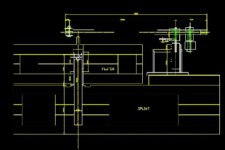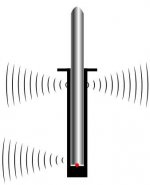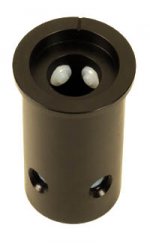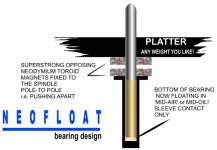Nanook said:ssmith, I "stole" your tonearm sketch and modded it to look like the one I built (I hope it's ok with you to do it, if not I apologize)
Shocking! How dare you?! My lawyers will be in touch!

Looks good. When I get around to making it, I think I'll try both types -- standard unipivot and the "dangling thread thingy (all rights reserved)".
Izhak -- sent you a message via the board, did you get it....?
DIY tonearm...
I started a thread or perhaps to revive interest in the DIY tonearms. See my new thread (pardon the pun) "DIY Tonearms"
I started a thread or perhaps to revive interest in the DIY tonearms. See my new thread (pardon the pun) "DIY Tonearms"
IZHAKKATZ and ssmith...
I did convert the drawing to PDF for others to see. I will post it here. But Izah, what program did you use to draw vit? AutoCad did not want to open it up, I had to use a free viewer and then a converter to do it...
your dimension style is very small, and not too readable, but any that see it will understand...The image I ended up posting is jpeg...PDF ws a pain in the a**
I did convert the drawing to PDF for others to see. I will post it here. But Izah, what program did you use to draw vit? AutoCad did not want to open it up, I had to use a free viewer and then a converter to do it...
your dimension style is very small, and not too readable, but any that see it will understand...The image I ended up posting is jpeg...PDF ws a pain in the a**
Attachments
SOLVED!
well, at least on paper and thanks to Izhak -- who I've been in touch with off list and who has been enormously helpful.
Basically, what Izhak has done is to use standard off-the shelf bearing parts. These can be found at at places such as mcmaster.com, sdp-si.com and smallparts.com (all US websites).
A stainless steel rod with 0.7500" diameter is attached to the plinth, sticking upwards. A self-lubricating sintered bronze sleeve, with an internal diameter of as close to 0.7500" as possible (such as 0.751", 0.752" or 0.753"), is placed inside the platter.
The inside end of the sleeve needs to be grooved by a machinist, so a retaining ring can be put inside.
Below the retaining ring goes a thrust plate, perhaps cut from a delrin rod and below that goes a ceramic ball (Izhak uses 3/8" diameter, like item number 9576K38 at McMaster-Carr ).
And then the shaft goes in the sleeve, and the thing should (in theory) spin.
I've been reading up on these bronze sleeves -- they are impregnated with oil and designed so that when it spins, the oil seeps out and lubricates, and when it's not spinning, the oil is absorbed back into the sleeve. Fascinating stuff.
And there you have it. Total cost well under $50.

I'm putting in the orders, and will pick the stuff up at christmas when I head to the US, and will keep you all posted.
well, at least on paper and thanks to Izhak -- who I've been in touch with off list and who has been enormously helpful.
Basically, what Izhak has done is to use standard off-the shelf bearing parts. These can be found at at places such as mcmaster.com, sdp-si.com and smallparts.com (all US websites).
A stainless steel rod with 0.7500" diameter is attached to the plinth, sticking upwards. A self-lubricating sintered bronze sleeve, with an internal diameter of as close to 0.7500" as possible (such as 0.751", 0.752" or 0.753"), is placed inside the platter.
The inside end of the sleeve needs to be grooved by a machinist, so a retaining ring can be put inside.
Below the retaining ring goes a thrust plate, perhaps cut from a delrin rod and below that goes a ceramic ball (Izhak uses 3/8" diameter, like item number 9576K38 at McMaster-Carr ).
And then the shaft goes in the sleeve, and the thing should (in theory) spin.
I've been reading up on these bronze sleeves -- they are impregnated with oil and designed so that when it spins, the oil seeps out and lubricates, and when it's not spinning, the oil is absorbed back into the sleeve. Fascinating stuff.
And there you have it. Total cost well under $50.

I'm putting in the orders, and will pick the stuff up at christmas when I head to the US, and will keep you all posted.
Hi ssmith,
I couldn't have explaned it any better then you.
Just make sure you use the highst tolerance for the shaft as well.
I used a Thompson shaft purchased from Msc but it had to be a special order to get the higher tolerance possible (it cost around $10.00).
I've also drilled a small hole off-center in the thrust plate so that I could drop oil from the top into the shaft. (its an invers bearing).
good luck with your project !!!
Izhak
I couldn't have explaned it any better then you.
Just make sure you use the highst tolerance for the shaft as well.
I used a Thompson shaft purchased from Msc but it had to be a special order to get the higher tolerance possible (it cost around $10.00).
I've also drilled a small hole off-center in the thrust plate so that I could drop oil from the top into the shaft. (its an invers bearing).
good luck with your project !!!
Izhak
as for the bearing...
...I have used an intake-valve, valve-guide and steel-ball from a Harley-Davidson motorcycle.
Works well.
http://www.altmann.haan.de/turntable
Charles 🙂
...I have used an intake-valve, valve-guide and steel-ball from a Harley-Davidson motorcycle.
Works well.
http://www.altmann.haan.de/turntable
Charles 🙂
WHO IS THE WORST OFFENDER HERE?
Which would you guys say is the worst noise/rumble culprit in a conventional turntable bearing housing?
the ball bearing part *or* the bearing sleeve?
how would you describe (hypothetically) the "holy grail" bearing, if it could be made.
I've had a great idea for a bearing design but don't want to make a fool of myself by overlooking some obvious flaw in my design. would anyone be interested in knowing?
cheers
Eric
Which would you guys say is the worst noise/rumble culprit in a conventional turntable bearing housing?
the ball bearing part *or* the bearing sleeve?
how would you describe (hypothetically) the "holy grail" bearing, if it could be made.
I've had a great idea for a bearing design but don't want to make a fool of myself by overlooking some obvious flaw in my design. would anyone be interested in knowing?
cheers
Eric
Attachments
Charles, I really really like your tt. I think I will follow in your footsteps as soon as I get a break from all of my oter DIY projects!
From the first post in this thread
I cannot open the links given (404 error). Does anyone know where there is information on this PLL DC solution?
ssmith said:
On my DIY TT, here is where I am now:
Motor:
Have the plan for a cheapo PLL-DC solution ($10)
( http://rcswww.urz.tu-dresden.de/~cs838136/krishu/dc2.htm )
I cannot open the links given (404 error). Does anyone know where there is information on this PLL DC solution?
Never underestimate the power of Google!
www.krishu.de
old.krishu.de (website before redesign, some of the pages are translated into english)
www.krishu.de
old.krishu.de (website before redesign, some of the pages are translated into english)
Another source is a Technics SL-1200mk2 bearing. It can be had for USD 30 from e.g. www.1200s.com.
- Harald
An externally hosted image should be here but it was not working when we last tested it.
- Harald
I read through nearly all of the therads, and what i see now, is what I thought before
-about platter bearings-
I think, no motor, car or bike parts are useful for this task.
I think the altmann turntable is something like a joke, and i wouldnt recommend using an intake-valve and a matching valve guide as a bushing, because the spindle has to fit exactly in the bushing.
A patter bearing from a cheap sony turntable fits so, that i can't even push the spindle in the bushing, because the air won't come out if the contact is oily. this won1t work with a motor intake valve, and we mustnt forget, that these motor parts are not designed for this kind of silent circular movement, but for fast vertical movements.
the excentricity of the spindle on the spindle on the top of the platter must be under 0,02 millimetres , so it is really hard to do a turntable in the altmann - way.
What i think is possible to be done, and maybe not so difficult, is the well tempered bearing.
the platter bearing is a really different approach, and not impossible to do a perfect bearing in the kitchen this way.
well tempered....
ps:excuse me for my english...😎
-about platter bearings-
I think, no motor, car or bike parts are useful for this task.
I think the altmann turntable is something like a joke, and i wouldnt recommend using an intake-valve and a matching valve guide as a bushing, because the spindle has to fit exactly in the bushing.
A patter bearing from a cheap sony turntable fits so, that i can't even push the spindle in the bushing, because the air won't come out if the contact is oily. this won1t work with a motor intake valve, and we mustnt forget, that these motor parts are not designed for this kind of silent circular movement, but for fast vertical movements.
the excentricity of the spindle on the spindle on the top of the platter must be under 0,02 millimetres , so it is really hard to do a turntable in the altmann - way.
What i think is possible to be done, and maybe not so difficult, is the well tempered bearing.
the platter bearing is a really different approach, and not impossible to do a perfect bearing in the kitchen this way.
well tempered....
ps:excuse me for my english...😎
Attachments
zagyvalaszlo said:I read through nearly all of the therads, and what i see now, is what I thought before
-about platter bearings-
I think, no motor, car or bike parts are useful for this task.
I think the altmann turntable is something like a joke, and i wouldnt recommend using an intake-valve and a matching valve guide as a bushing, because the spindle has to fit exactly in the bushing.
A patter bearing from a cheap sony turntable fits so, that i can't even push the spindle in the bushing, because the air won't come out if the contact is oily. this won1t work with a motor intake valve, and we mustnt forget, that these motor parts are not designed for this kind of silent circular movement, but for fast vertical movements.
the excentricity of the spindle on the spindle on the top of the platter must be under 0,02 millimetres , so it is really hard to do a turntable in the altmann - way.
seems that you didn't have opportunity to hear and dismantle many turntables ?
what I can see on altman's site is fine example of pure practical engineering,and that only can lead to fine sounding TT ;
I didn't say -best TT ; just fine sounding -just because there is not such thing like best TT
forgive me if I sounded very much against the altmann DIY turntable. That was not ment to be my point. That was one of the projects that inspired me to build my own TT. And after building it, I had to realize, that it is not so easy to do, as it seems.
I only tried to explain, that in my opinion a bearing of the cheap sony, that you can purchase for a few euros is probably does the job better than a motor intake valve, so if you use a pre-manufactured element, why would you use a motor part rather than a turntable part? 😕
And if we want to make our own bearing, it seems easier to do a well tempered - like bearing, from teflon screws, and a spindle, than to try to make a conventional bearing with very precise metal work.
I only tried to explain, that in my opinion a bearing of the cheap sony, that you can purchase for a few euros is probably does the job better than a motor intake valve, so if you use a pre-manufactured element, why would you use a motor part rather than a turntable part? 😕
And if we want to make our own bearing, it seems easier to do a well tempered - like bearing, from teflon screws, and a spindle, than to try to make a conventional bearing with very precise metal work.

probably harley davidson intake valves match more precisely into matching valve-guides than most others. Never had the opportunity to dismantle one.
Tha is what I think too. The tolerance should be great enough to withstand a very large pressure inside the engine. Also, any play in an assembly like that would very quickly turn to wear at several thousand operations per second. I should think in comparison, a TT bearing is farely light duty.
Generally speakingg the cam is ground at a slight angle to intentionally rotate the valve at around 10rpm to keep valve seat wear even, so it does have to cope with some rotation even in its intended use. I can't see a problem, sounds ideal to me. It wouldn't have to be a Harley valve either, its just that the heads are quite large (large cylinder size), and they aren't massively tuned with skinny little stems like some quicker engines would use.
Steve
Steve
- Status
- Not open for further replies.
- Home
- Source & Line
- Analogue Source
- HELP!!! anyone sourced a DIY bearing?



